Native Plants For Your Garden
By Ann Dozier Master Gardener
To save water and discourage deer, I’d like to replant some of my flower beds using native plants, but I’m afraid my summer garden will lack color. Do you have some suggestions?
Carol D., Atascadero
Native plants are great additions to Central Coast gardens, and they are easy to buy and grow here. However, you’re right in thinking that many are not summer-flowering; often they bloom in spring and are summer-dormant. Still, you can have an attractive, low-water garden year round by choosing a rich blend of contrasting textures, shapes and foliage colors. Several perennials such as penstemon and monkey flower (Mimulus) do bloom into July, while others like California fuchsia begin bloom in August.
If after research you feel you’ll want more color than natives provide, you can add some summer-flowering plants from other Mediterranean climate zones to your mix. When choosing natives for your garden, pick those that like your climate and soil. Natives of sandy, foggy beach areas will have a hard time surviving in North County. While planning, also try to group those plants that like the same amount of water. Many California natives do not do well with regular summer watering; be especially careful to provide good drainage in clay soils.
Fall is the best time to plant natives; they will have several weeks to get established before cold weather begins. However, do take time to gather ideas for your plantings. The SLO Botanical Garden and the Cal Poly Arboretum are good places to see plants in groupings that mimic their natural habitat. Most local nurseries also have native plant sections. Online, browse www.slowaterwiselandscaping.com or go to www.arboretum.ucdavis.edu/ and click on “all stars.” Libraries also offer beautiful books about gardening in dry climates.
These sources usually mention deer resistance; unfortunately hungry deer will graze on many natives. Often they take tender leaves and blossoms without killing well established plants. Sages and other aromatic plants are usually avoided. Individual plant protectors are practical deterrents. For more information about managing deer, go to http://www.ipm.ucdavis.edu/PMG/PESTNOTES/pn74117.html
